Tezos Price Analysis - Carthage Amendment brings a fleeting price high
#crypto #bitcoin
OhNoCrypto
via https://www.ohnocrypto.com
Josh Olszewicz, Khareem Sudlow
Tezos (XTZ) is a decentralized smart contract and application network, with an on-chain governance layer designed to enable efficient network upgrades and provide a transparent stakeholder community. The asset is currently 10th on the BraveNewCoin market cap table, with a market cap of US$1.06 billion, and US$82 million in trade volume over the past 24 hours.
A quick comparison between coins using a staking mechanism shows XTZ leading by market cap and second in total daily transaction volume. XTZ is near the bottom of the group in all other categories. According to stakingrewards.com, the XTZ real staking yield, or staking yield minus inflation, is currently +1.30%.
EOS (EOS) was excluded from the on-chain data comparison due to a lack of currently available reliable on-chain data.
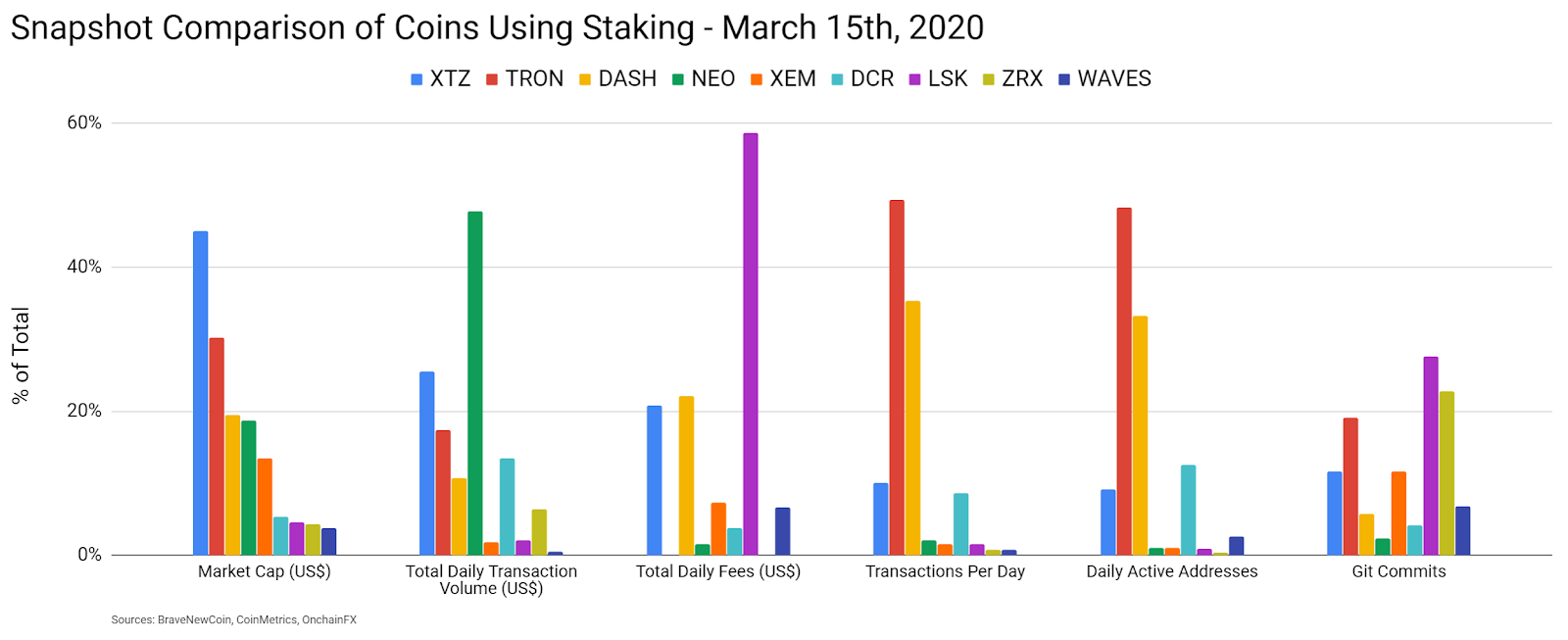
Portions of the XTZ model were first conceived by Gordon Mohr and L.M. Goodman in late 2013 and early 2014. Kathleen Breitman and Arthur Breitman released the first Tezos position paper and white paper in late 2014.
Initial development started in the setting of both Bitcoin and Ethereum scaling and governance disputes. The project went on to secure funding in 2016, which was provided by Polychain Capital. Notable advisors include Emin Gün Sirer and Zooko Wilcox of Zcash.
The Switzerland-based Tezos Foundation was created in April 2017, with the goal of providing support to XTZ, related technologies, and the XTZ community. The project’s initial coin offering (ICO) occurred from July 1st to July 13th, 2017 when each token was sold for US$0.47. The ICO raised a total of 65,000 BTC and 325,000 ETH, or US$232 million, which made it one of the largest ICOs at the time.
As of August 2019, the Tezos Foundation holds a reported US$652 million in mixed assets; 61% in BTC, 15% in XTZ, 15% in bonds, ETFs, and commodities at Swiss banks, 6% in fiat, and 3% in other assets. A more recent report on the Tezos Foundation financials could not be obtained.
Following the ICO, a dispute between then Tezos Foundation president Johann Gevers and the Breitmans pushed initial development back multiple months. Additionally, in October 2017, a class-action lawsuit was registered against Tezos in the Superior Court of California, citing "violation of the registration and anti-fraud provisions of the federal securities laws, as well as state false advertising, and unfair competition laws."
In June 2018, Know Your Customer (KYC) and Anti-Money Laundering (AML) requirements were announced, which included user identity information that wasn’t initially collected during the ICO. The genesis block was also completed in June 2018, when 608 million XTZ were created. There is currently no limit on the total supply. The mainnet went live in September 2018 with ICO tokens unlocking in November 2018.
In late January, the Tezos Foundation announced a third round of ecosystem grants, for 21 new projects. These funded proposals involve applications built using XTZ smart contracts, tools for smart contract development, educational or training resources, and marketing materials.
Last month, the Tezos Foundation president, Ryan Jesperson, announced he would not be seeking re-election for the role in the Spring. He will also abstain from voting on the new candidate. A Nomination Committee consisting of Hubertus Thonhauser, Alexis Bonte, Ryan Lackey, and Ulrich Sauter was formed and is set to release council nominations in the coming weeks.
The Tezos ledger uses a delegated Proof of Stake consensus mechanism with a target block time of one minute and current annual inflation of 3.6% after the latest protocol upgrade. Nearly 80% of the current circulating supply is participating in staking, or ‘baking’ on the XTZ chain, which is among the highest total USD value of all Proof of Stake (PoS) chains.
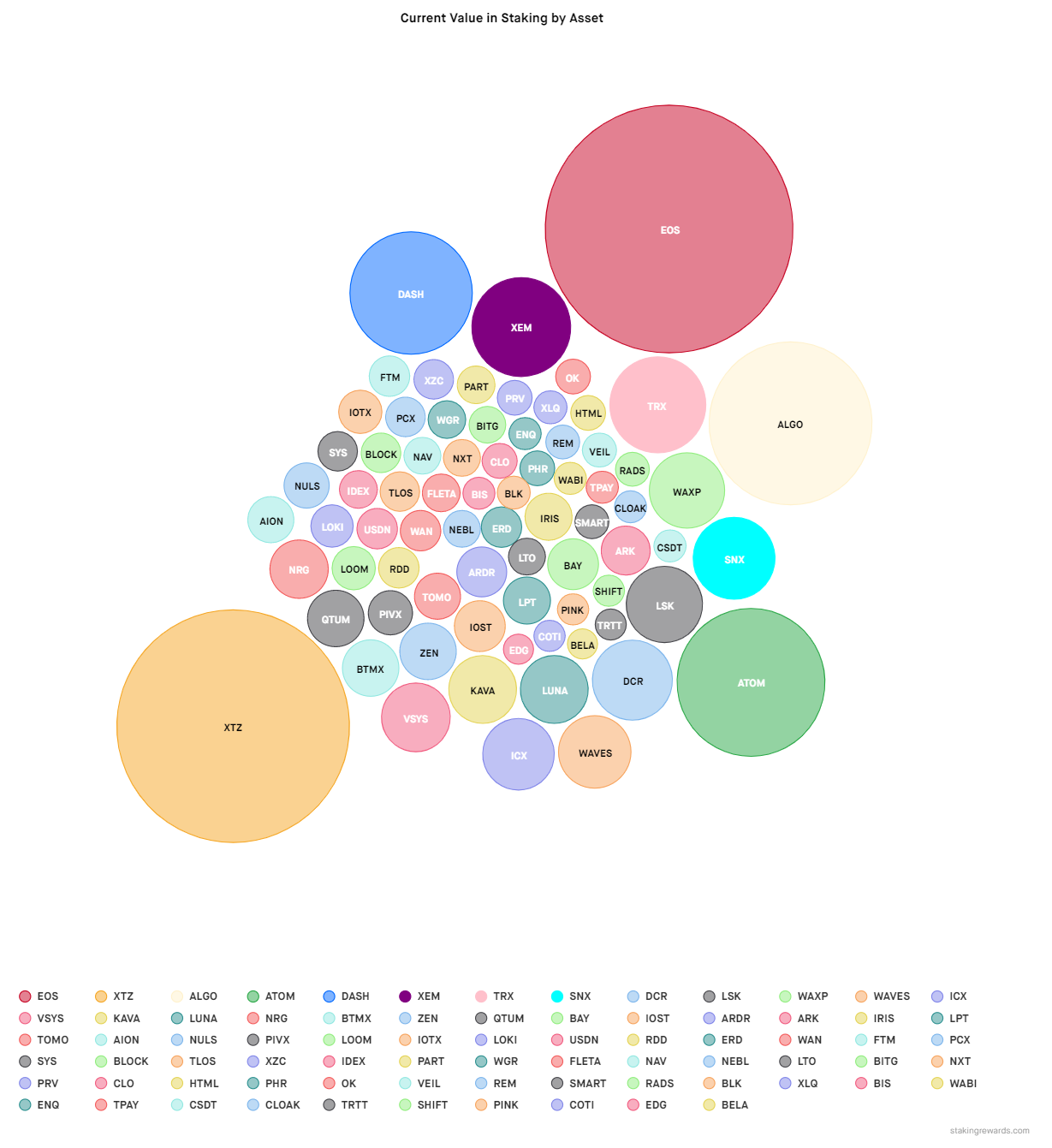
Source: StakingRewards
Tokens need to be delegated to a baker to earn block rewards. There are seven exchange bakeries, with Coinbase holding the lion’s share. In total, just over 15% of the Tezos circulating supply is held on exchange bakeries. Initially, bakers needed at least 10,000 XTZ to become a delegate, which has dropped to 8,000 XTZ, or US$12,320 at current prices. Users with less than 8,000 XTZ can also participate in staking through delegation services.
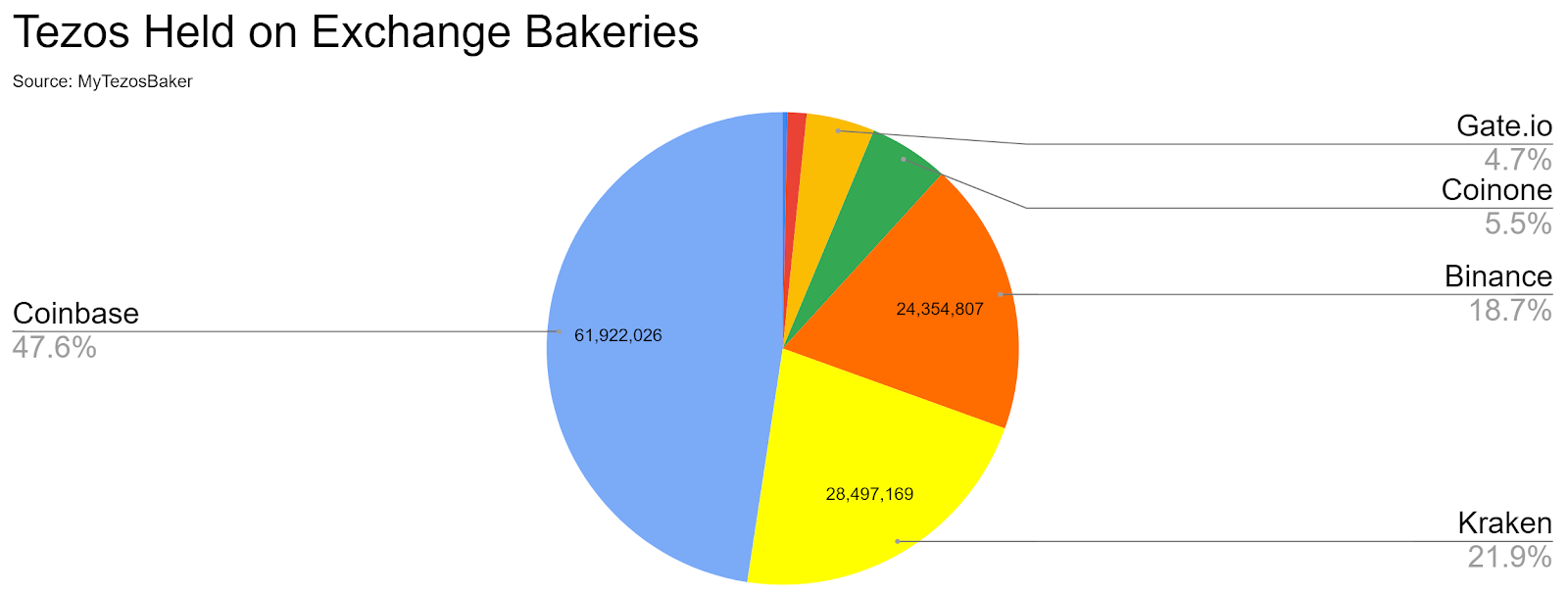
Bakers can manage XTZ nodes and participate in protocol amendments, as well as software updates and patches. Bakers also charge delegators for their services as network amenders and block producers. At the beginning of each cycle (4,096 blocks or about three days), the Bakers for each block are randomly selected and published. Bakers earn a block reward of 16 XTZ for baking a block. In addition to the Baker, 32 Endorsers are randomly selected to verify the last block that was baked. Endorsers receive 2 XTZ for each block they endorse.
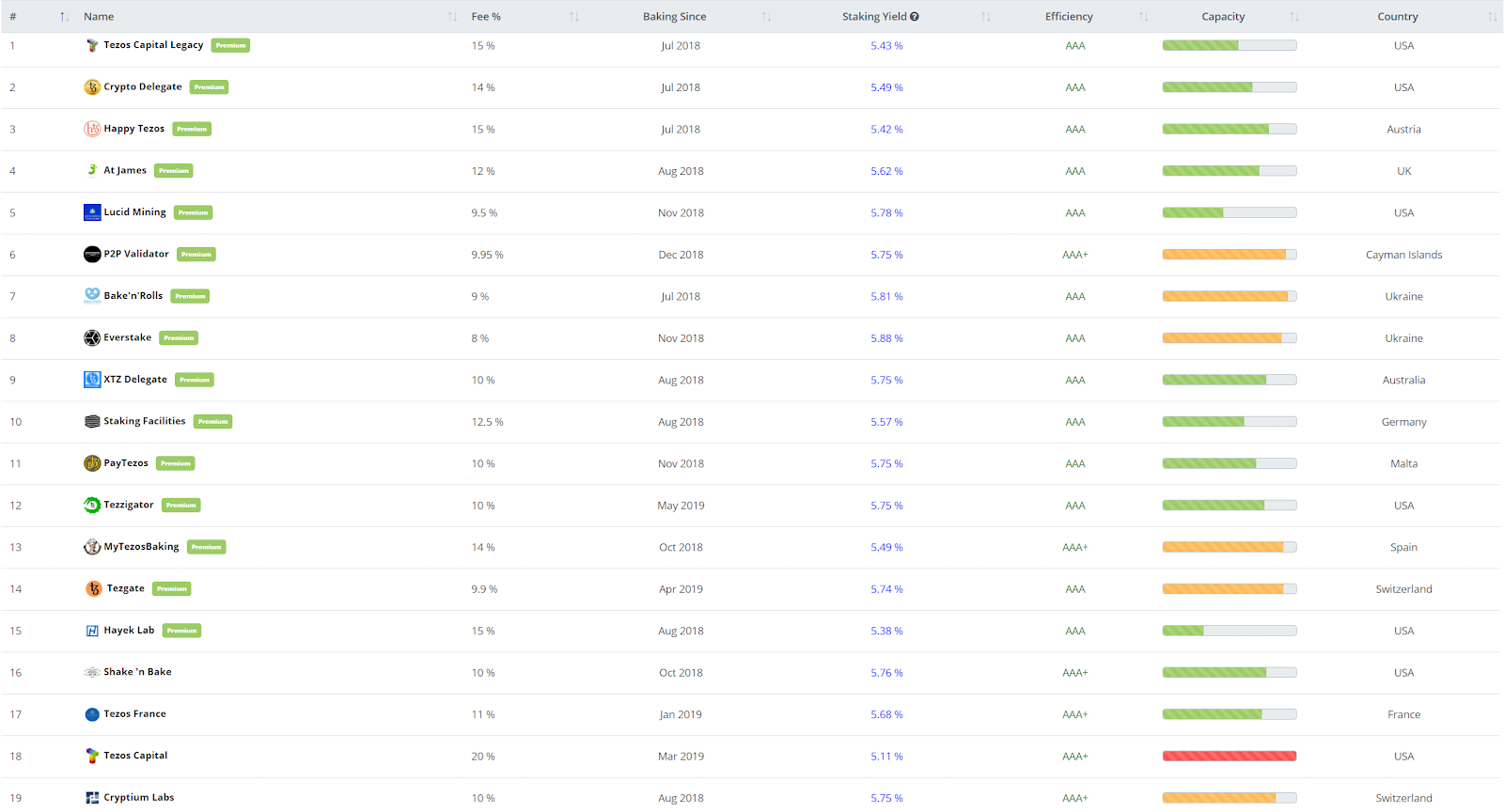
Source: MyTezosBaker
Protocol amendments are adopted over election cycles that are 131,072 blocks long, or roughly three months. Amendments are only voted on by the community, and not by the Tezos Foundation. In late May 2019, the XTZ community voted to activate Athens, the first XTZ on-chain governance proposal. Athens increased the gas limit to allow for larger transaction throughput and reduced the minimum amount of XTZ required to bake, from 10,000 XTZ to 8,000 XTZ.
The Babylon 2.0 amendment was implemented in October. The Babylon upgrades included; changing the consensus algorithm to Emmy+, which makes smart contracts in the scripting language Michelson easier to write, distinguishing accounts from smart contracts, and changing quorum floors and caps.
The Carthage 2.0 amendment was implemented earlier this month. The Carthage upgrades included; increasing the gas limit per block and per operation by 30%, improving the accuracy and resiliency of the formula used for calculating baking and endorsing rewards and various other small fixes. The reward formula was also altered to grant up to 40 XTZ to the baker and 1.25 XTZ to each endorser. This change holds expected rewards constant and makes selfish baking effectively unprofitable for bakers who control less than 20-25% of stake.
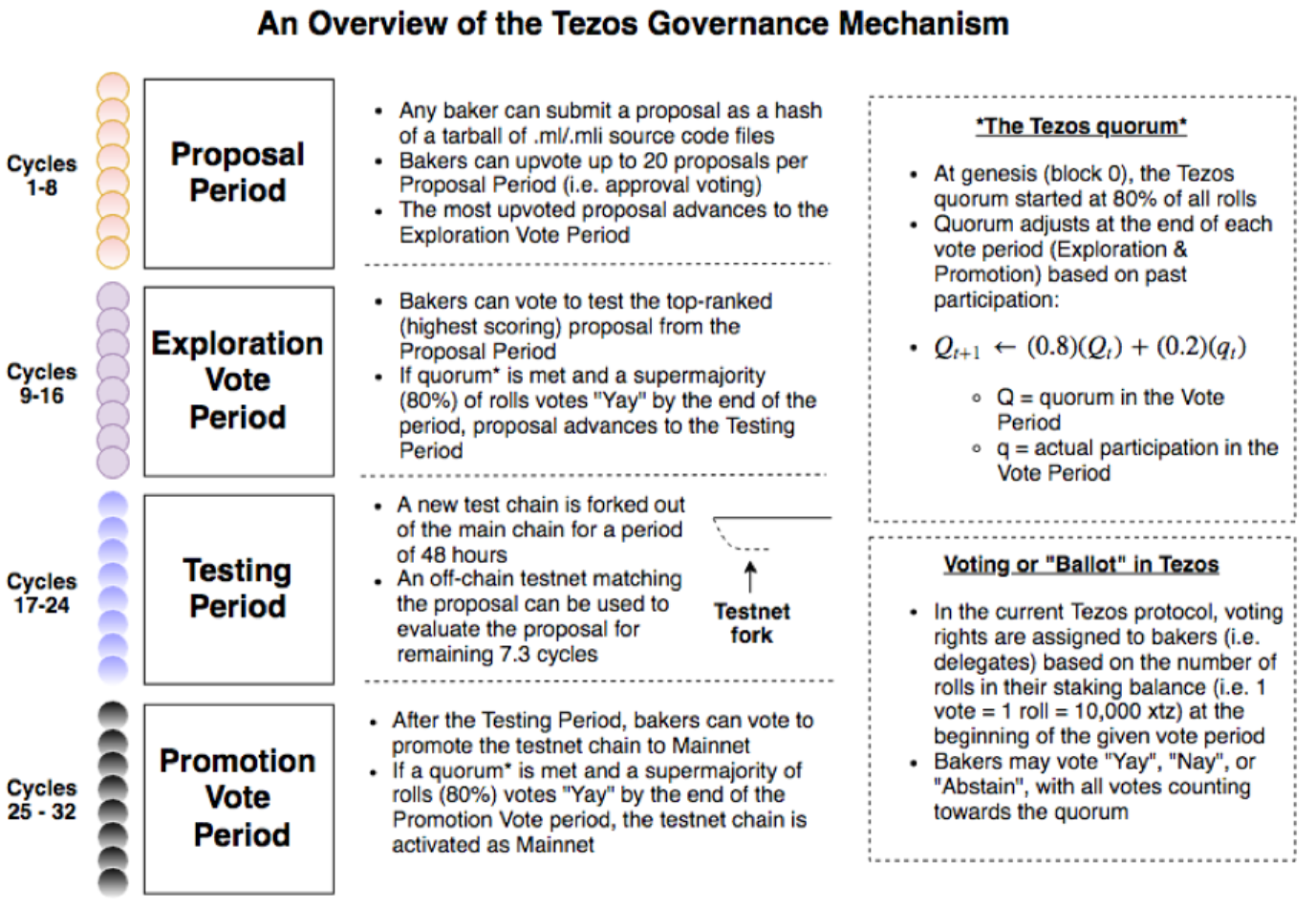
Source: Tezos Blog
On the network, the current total number of transactions per day (line, chart below) have continued to slowly increase over the past year, closely correlated with the XTZ token price. Average transaction fees (fill, chart below) have also continued to increase in this same period, and are currently US$0.00232. Average transaction values have ranged from US$200 to US$6,000 over the past 15 months (not shown).
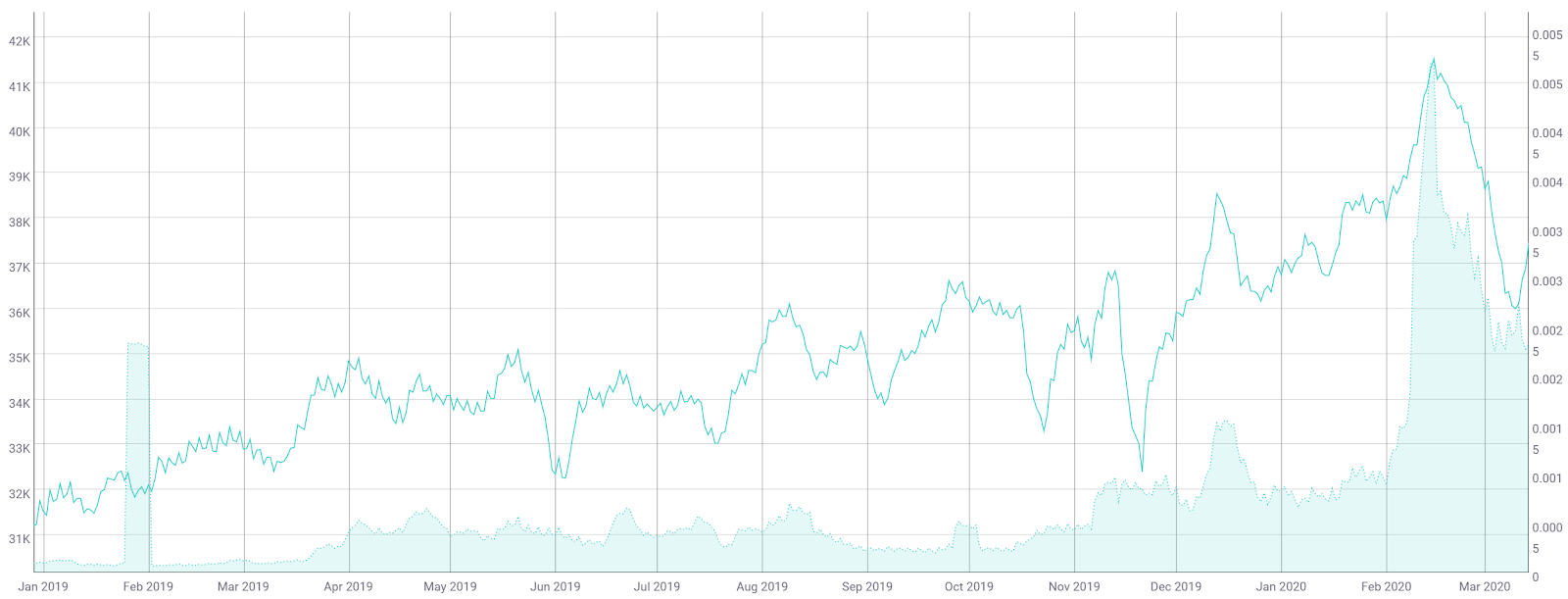
Source: CoinMetrics
The 30-day Kalichkin network value to estimated on-chain daily transactions (NVT) ratio (line, chart below) is currently 143, falling, and near the middle of the historic norm. Inflection points in NVT can be leading indicators of a reversal in asset value.
An uptrend in NVT often suggests a coin is overvalued based on its economic activity and utility, which should be seen as a bearish price indicator, whereas a downtrend in NVT suggests the opposite. NVT below 100 typically indicates organic and sustained bull market conditions.
Active and unique addresses also are important to consider, specifically when determining the fundamental value of the network based on Metcalfe's law. Monthly active addresses (MAAs) have continued to increase since January 2019 (fill, chart below), recently hitting an all-time high post ICO distribution. In November 2018, addresses spiked due to the release of the claimed tokens from the ICO. A consistent and sustained increase in MAAs paints a bullish picture for any asset.
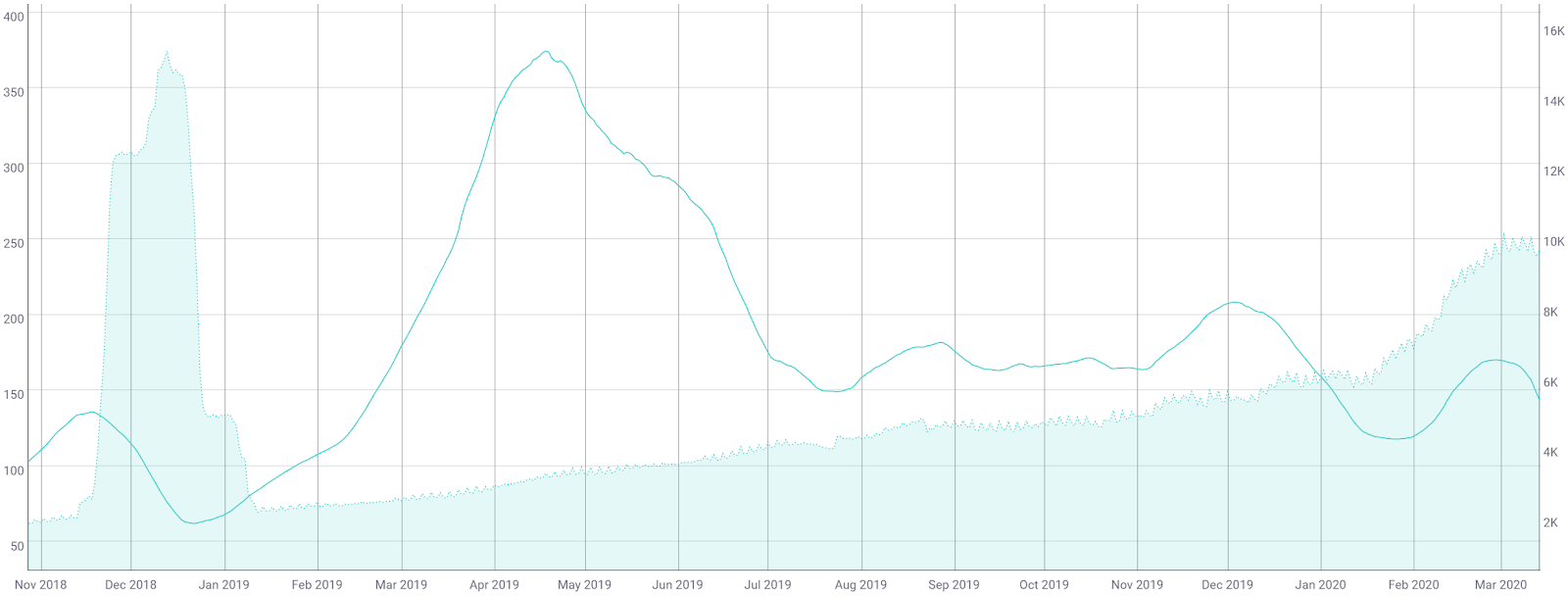
Source: CoinMetrics
The XTZ project is programmed in OCaml with the main repo on GitLab recording nearly 1,500 commits over the past year (shown below). As of last year, the Tezos Foundation reported 1,338 developers have completed or are working to complete the Tezos training course.
Most coins use the developer community of Github or GitLab where files are saved in folders called "repositories," or "repos," and changes to these files are recorded with "commits," which save a record of what changes were made, when, and by who. Although commits represent quantity and not necessarily quality, a higher number of commits can signify higher dev activity and interest.

Source: GitLab
In the markets, XTZ exchange volume has been led by the Tether (USDT), Bitcoin (BTC), and USD pairs on Binance, Coinbase, OKEx, and Kraken.
XTZ was listed on HitBTC in July 2017, Gate.io in July 2018, Bitfinex in September 2018, Kraken in October 2018, Huobi in December 2018, Coinbase and eToro in August 2019, Binance in September 2019, OKEx in November 2019, and Bittrex in December 2019. Bitfinex also added XTZ/USD and XTZ/BTC margin pairs in August. XTZ is not currently listed on Gemini or Poloniex.
Binance, Coinbase, Coinone, Gate.io, Kraken, Kucoin, OKEx, and the Trezor and Ledger hardware wallets provide staking support for XTZ.
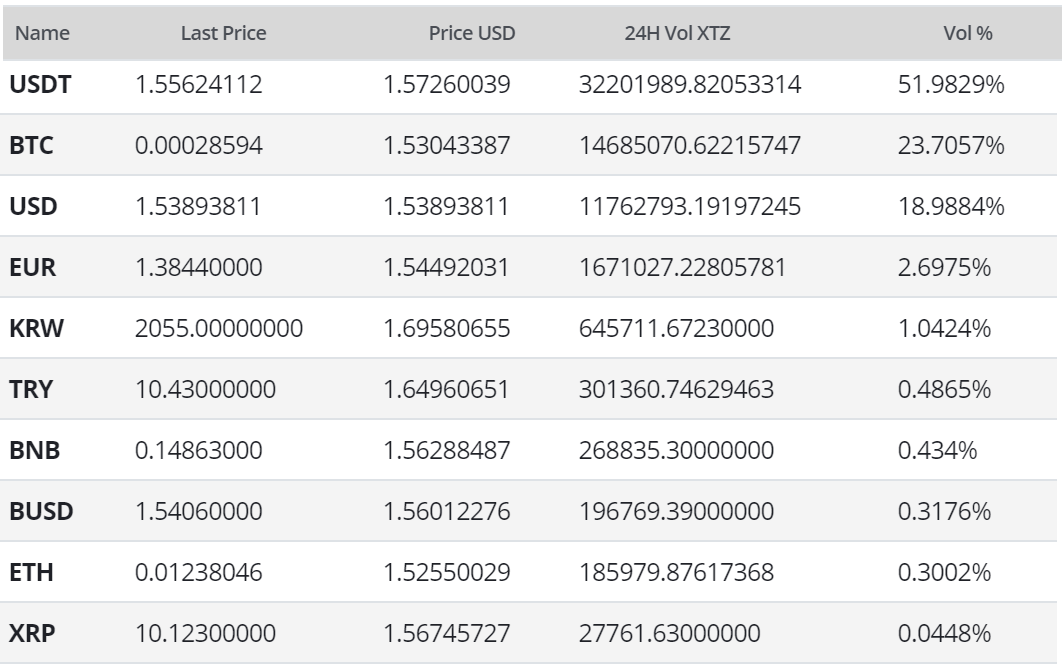
Worldwide Google Trends data for the term "tezos" has increased with each voting amendment and spot price increases. The July 2017 spike in “tezos” searches corresponds with the project’s ICO. Google Trends data has been found to have some correlation with crypto prices. A 2015 study found a strong correlation between the Google Trends data and BTC price, while a 2017 study concluded that when the U.S. Google "bitcoin" searches increased dramatically, BTC price dropped.

Bitfinex open interest (top panel, chart below) has sloshed around since the beginning of the year, with both shorts and longs reaching a new all-time high, then decreasing substantially. Open interest is currently 61% long. Additionally, there are no bullish or bearish divergences on volume or RSI.
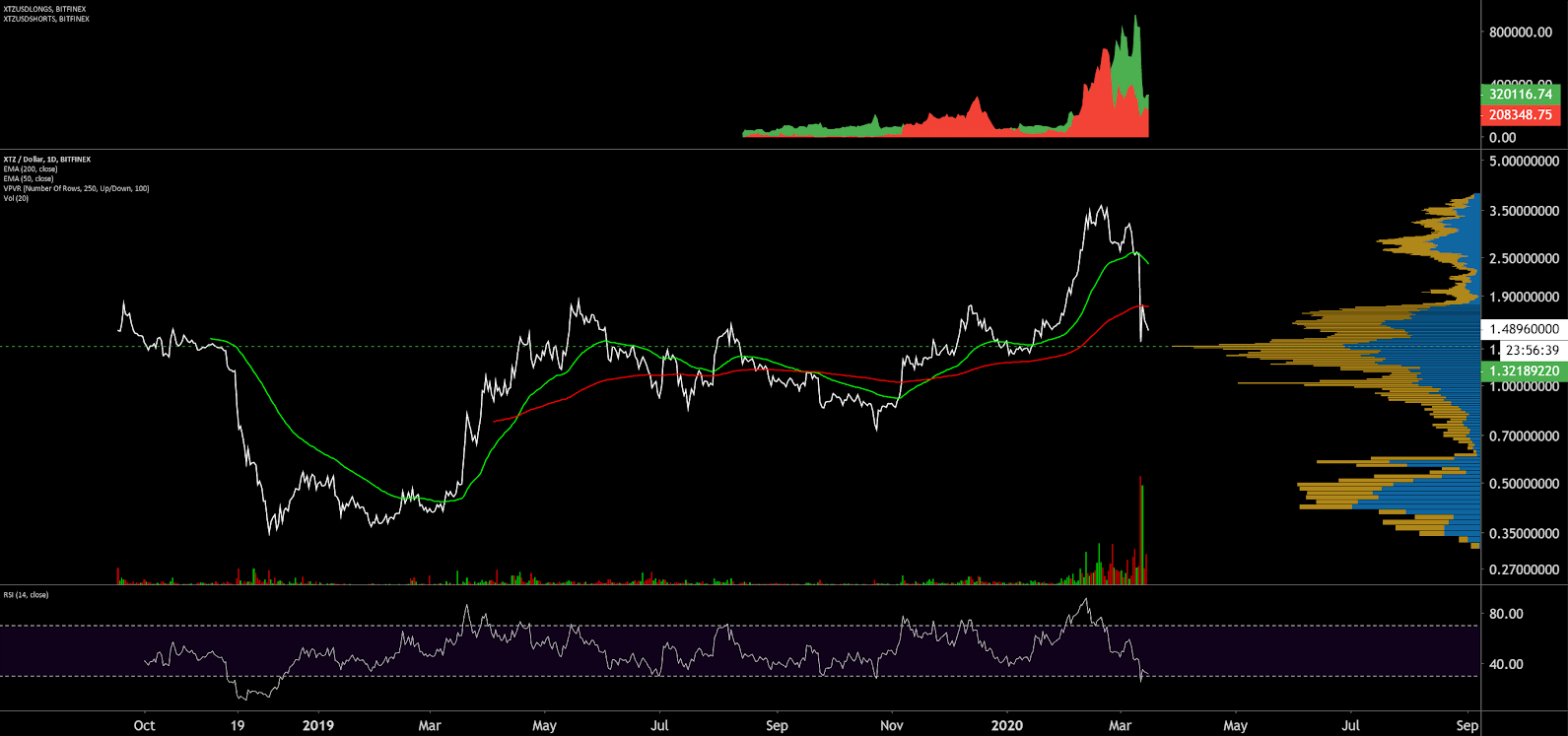
Turning to the Ichimoku Cloud, four metrics are used to indicate if a trend exists; the current price in relation to the Cloud, the color of the Cloud (red for bearish, green for bullish), the Tenkan (T) and Kijun (K) cross, and the Lagging Span. The best entry always occurs when most of the signals flip from bearish to bullish, or vice versa.
Cloud metrics on the daily time frame, with doubled settings (20/60/120/30) for more accurate signals, are currently bearish; the spot price is below the Cloud, the Cloud is bearish, the TK cross is bearish, and the Lagging Span is below the Cloud and below price. Price is currently 40% below the Kijun, which is suggestive of oversold conditions.
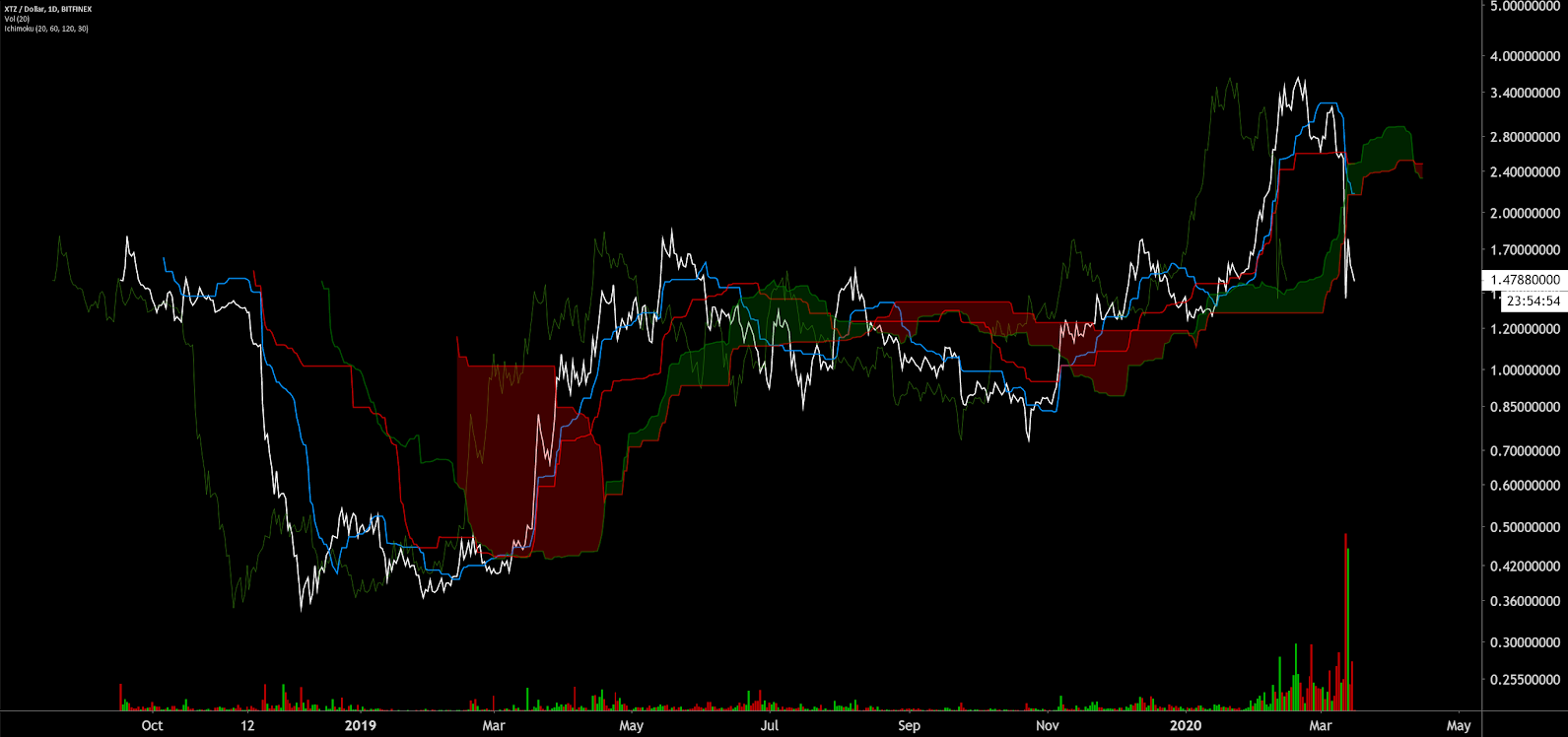
On the daily chart for the XTZ/BTC pair, the spot price broke above both the 200-day EMA and daily Cloud on November 7th, leading to a 108% bull rally. Price returned to the 200-day EMA on January 16th and then led to a 95% bullish rally. Cloud metrics are also currently all bullish, with the spot price sitting just above Kijun.
RSI and volume show no bearish divergences. Historic volume support sits at the psychological zone of 20,000 sats, near the 200-day EMA. Bitfinex open interest is 79% short and primed for a short squeeze if prices move higher. Price may need to reconsolidate near the all-time high zone before further attempts at higher highs.
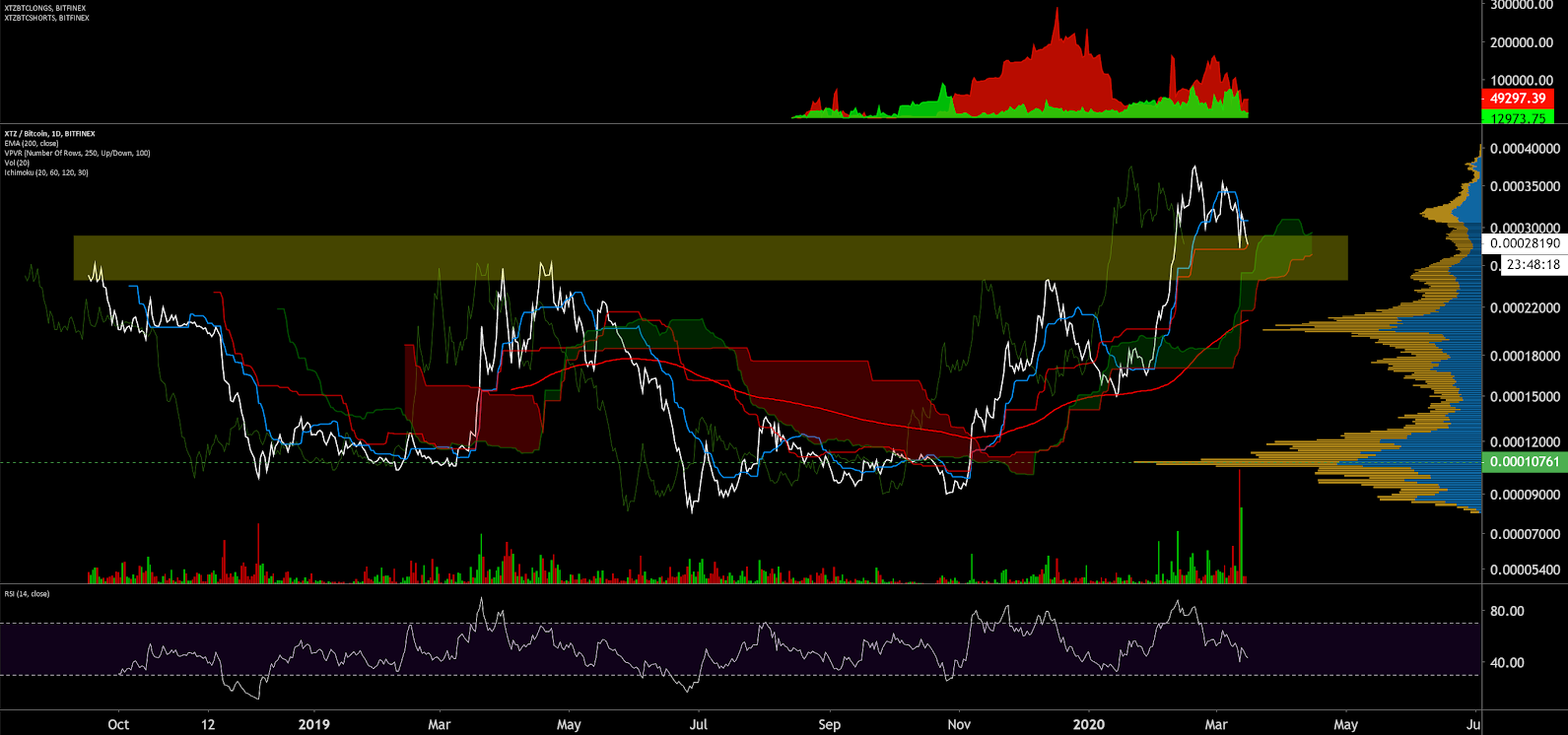
The high percentage of staked circulating supply, at nearly 80%, may suggest there is not much else to do with XTZ currently, as smart contracts and dapps have yet to take hold. The high staking percentage is likely related to several exchanges and custody services allowing for staking participation. Currently, just over 17% of the XTZ circulating supply is held by exchange bakeries. Worldwide Google Trends continues to paint a bullish picture for the asset so long as Trends holds above historic levels.
Technicals for the XTZ/USD pair have flipped strongly bearish over the past week, along with the rest of the crypto markets. Upside resistance sits at the VPVR level of US$2.70 and strong VPVR support sits at US$1.30 based on the volume profile.
Technicals for the XTZ/BTC suggest a more bullish picture. Price sits at the previous all-time high zone as well as the daily Kijun. Strong downside support sits at the psychological level of 20,000 sats which also has confluence with the 200-day EMA and VPVR zone. A bullish resolution to the current price structure will very likely bring the spot price to new all-time highs.
A quick comparison between coins using a staking mechanism shows XTZ leading by market cap and second in total daily transaction volume. XTZ is near the bottom of the group in all other categories. According to stakingrewards.com, the XTZ real staking yield, or staking yield minus inflation, is currently +1.30%.
EOS (EOS) was excluded from the on-chain data comparison due to a lack of currently available reliable on-chain data.

Portions of the XTZ model were first conceived by Gordon Mohr and L.M. Goodman in late 2013 and early 2014. Kathleen Breitman and Arthur Breitman released the first Tezos position paper and white paper in late 2014.
Initial development started in the setting of both Bitcoin and Ethereum scaling and governance disputes. The project went on to secure funding in 2016, which was provided by Polychain Capital. Notable advisors include Emin Gün Sirer and Zooko Wilcox of Zcash.
The Switzerland-based Tezos Foundation was created in April 2017, with the goal of providing support to XTZ, related technologies, and the XTZ community. The project’s initial coin offering (ICO) occurred from July 1st to July 13th, 2017 when each token was sold for US$0.47. The ICO raised a total of 65,000 BTC and 325,000 ETH, or US$232 million, which made it one of the largest ICOs at the time.
As of August 2019, the Tezos Foundation holds a reported US$652 million in mixed assets; 61% in BTC, 15% in XTZ, 15% in bonds, ETFs, and commodities at Swiss banks, 6% in fiat, and 3% in other assets. A more recent report on the Tezos Foundation financials could not be obtained.
Following the ICO, a dispute between then Tezos Foundation president Johann Gevers and the Breitmans pushed initial development back multiple months. Additionally, in October 2017, a class-action lawsuit was registered against Tezos in the Superior Court of California, citing "violation of the registration and anti-fraud provisions of the federal securities laws, as well as state false advertising, and unfair competition laws."
In June 2018, Know Your Customer (KYC) and Anti-Money Laundering (AML) requirements were announced, which included user identity information that wasn’t initially collected during the ICO. The genesis block was also completed in June 2018, when 608 million XTZ were created. There is currently no limit on the total supply. The mainnet went live in September 2018 with ICO tokens unlocking in November 2018.
In late January, the Tezos Foundation announced a third round of ecosystem grants, for 21 new projects. These funded proposals involve applications built using XTZ smart contracts, tools for smart contract development, educational or training resources, and marketing materials.
Last month, the Tezos Foundation president, Ryan Jesperson, announced he would not be seeking re-election for the role in the Spring. He will also abstain from voting on the new candidate. A Nomination Committee consisting of Hubertus Thonhauser, Alexis Bonte, Ryan Lackey, and Ulrich Sauter was formed and is set to release council nominations in the coming weeks.
The Tezos ledger uses a delegated Proof of Stake consensus mechanism with a target block time of one minute and current annual inflation of 3.6% after the latest protocol upgrade. Nearly 80% of the current circulating supply is participating in staking, or ‘baking’ on the XTZ chain, which is among the highest total USD value of all Proof of Stake (PoS) chains.

Source: StakingRewards
Tokens need to be delegated to a baker to earn block rewards. There are seven exchange bakeries, with Coinbase holding the lion’s share. In total, just over 15% of the Tezos circulating supply is held on exchange bakeries. Initially, bakers needed at least 10,000 XTZ to become a delegate, which has dropped to 8,000 XTZ, or US$12,320 at current prices. Users with less than 8,000 XTZ can also participate in staking through delegation services.

Bakers can manage XTZ nodes and participate in protocol amendments, as well as software updates and patches. Bakers also charge delegators for their services as network amenders and block producers. At the beginning of each cycle (4,096 blocks or about three days), the Bakers for each block are randomly selected and published. Bakers earn a block reward of 16 XTZ for baking a block. In addition to the Baker, 32 Endorsers are randomly selected to verify the last block that was baked. Endorsers receive 2 XTZ for each block they endorse.

Source: MyTezosBaker
Protocol amendments are adopted over election cycles that are 131,072 blocks long, or roughly three months. Amendments are only voted on by the community, and not by the Tezos Foundation. In late May 2019, the XTZ community voted to activate Athens, the first XTZ on-chain governance proposal. Athens increased the gas limit to allow for larger transaction throughput and reduced the minimum amount of XTZ required to bake, from 10,000 XTZ to 8,000 XTZ.
The Babylon 2.0 amendment was implemented in October. The Babylon upgrades included; changing the consensus algorithm to Emmy+, which makes smart contracts in the scripting language Michelson easier to write, distinguishing accounts from smart contracts, and changing quorum floors and caps.
The Carthage 2.0 amendment was implemented earlier this month. The Carthage upgrades included; increasing the gas limit per block and per operation by 30%, improving the accuracy and resiliency of the formula used for calculating baking and endorsing rewards and various other small fixes. The reward formula was also altered to grant up to 40 XTZ to the baker and 1.25 XTZ to each endorser. This change holds expected rewards constant and makes selfish baking effectively unprofitable for bakers who control less than 20-25% of stake.

Source: Tezos Blog
On the network, the current total number of transactions per day (line, chart below) have continued to slowly increase over the past year, closely correlated with the XTZ token price. Average transaction fees (fill, chart below) have also continued to increase in this same period, and are currently US$0.00232. Average transaction values have ranged from US$200 to US$6,000 over the past 15 months (not shown).

Source: CoinMetrics
The 30-day Kalichkin network value to estimated on-chain daily transactions (NVT) ratio (line, chart below) is currently 143, falling, and near the middle of the historic norm. Inflection points in NVT can be leading indicators of a reversal in asset value.
An uptrend in NVT often suggests a coin is overvalued based on its economic activity and utility, which should be seen as a bearish price indicator, whereas a downtrend in NVT suggests the opposite. NVT below 100 typically indicates organic and sustained bull market conditions.
Active and unique addresses also are important to consider, specifically when determining the fundamental value of the network based on Metcalfe's law. Monthly active addresses (MAAs) have continued to increase since January 2019 (fill, chart below), recently hitting an all-time high post ICO distribution. In November 2018, addresses spiked due to the release of the claimed tokens from the ICO. A consistent and sustained increase in MAAs paints a bullish picture for any asset.

Source: CoinMetrics
The XTZ project is programmed in OCaml with the main repo on GitLab recording nearly 1,500 commits over the past year (shown below). As of last year, the Tezos Foundation reported 1,338 developers have completed or are working to complete the Tezos training course.
Most coins use the developer community of Github or GitLab where files are saved in folders called "repositories," or "repos," and changes to these files are recorded with "commits," which save a record of what changes were made, when, and by who. Although commits represent quantity and not necessarily quality, a higher number of commits can signify higher dev activity and interest.

Source: GitLab
In the markets, XTZ exchange volume has been led by the Tether (USDT), Bitcoin (BTC), and USD pairs on Binance, Coinbase, OKEx, and Kraken.
XTZ was listed on HitBTC in July 2017, Gate.io in July 2018, Bitfinex in September 2018, Kraken in October 2018, Huobi in December 2018, Coinbase and eToro in August 2019, Binance in September 2019, OKEx in November 2019, and Bittrex in December 2019. Bitfinex also added XTZ/USD and XTZ/BTC margin pairs in August. XTZ is not currently listed on Gemini or Poloniex.
Binance, Coinbase, Coinone, Gate.io, Kraken, Kucoin, OKEx, and the Trezor and Ledger hardware wallets provide staking support for XTZ.

Worldwide Google Trends data for the term "tezos" has increased with each voting amendment and spot price increases. The July 2017 spike in “tezos” searches corresponds with the project’s ICO. Google Trends data has been found to have some correlation with crypto prices. A 2015 study found a strong correlation between the Google Trends data and BTC price, while a 2017 study concluded that when the U.S. Google "bitcoin" searches increased dramatically, BTC price dropped.

Technical Analysis
On the daily chart for the XTZ/USD pair, the 50-day Exponential Moving Average (EMA) and 200-day EMA crossed bullishly on November 18th, and a 250% bull rally followed. Volume increased substantially after January and hit an all-time high on March 12th. Historical volume support (horizontal bars, chart below) sits at US$1.32 with resistance around US$2.80Bitfinex open interest (top panel, chart below) has sloshed around since the beginning of the year, with both shorts and longs reaching a new all-time high, then decreasing substantially. Open interest is currently 61% long. Additionally, there are no bullish or bearish divergences on volume or RSI.

Turning to the Ichimoku Cloud, four metrics are used to indicate if a trend exists; the current price in relation to the Cloud, the color of the Cloud (red for bearish, green for bullish), the Tenkan (T) and Kijun (K) cross, and the Lagging Span. The best entry always occurs when most of the signals flip from bearish to bullish, or vice versa.
Cloud metrics on the daily time frame, with doubled settings (20/60/120/30) for more accurate signals, are currently bearish; the spot price is below the Cloud, the Cloud is bearish, the TK cross is bearish, and the Lagging Span is below the Cloud and below price. Price is currently 40% below the Kijun, which is suggestive of oversold conditions.

On the daily chart for the XTZ/BTC pair, the spot price broke above both the 200-day EMA and daily Cloud on November 7th, leading to a 108% bull rally. Price returned to the 200-day EMA on January 16th and then led to a 95% bullish rally. Cloud metrics are also currently all bullish, with the spot price sitting just above Kijun.
RSI and volume show no bearish divergences. Historic volume support sits at the psychological zone of 20,000 sats, near the 200-day EMA. Bitfinex open interest is 79% short and primed for a short squeeze if prices move higher. Price may need to reconsolidate near the all-time high zone before further attempts at higher highs.

Conclusion
After a rocky start in 2017, Tezos enters a crowded field of PoS coins with the hopes of solving crippling governance issues that have previously plagued both Bitcoin and Ethereum. All three protocol upgrades thus far - Athens, Babylon, and Carthage - have all been implemented flawlessly. Fundamentals reflect a nascent chain with rising daily transactions and increasing active addresses over the past year.The high percentage of staked circulating supply, at nearly 80%, may suggest there is not much else to do with XTZ currently, as smart contracts and dapps have yet to take hold. The high staking percentage is likely related to several exchanges and custody services allowing for staking participation. Currently, just over 17% of the XTZ circulating supply is held by exchange bakeries. Worldwide Google Trends continues to paint a bullish picture for the asset so long as Trends holds above historic levels.
Technicals for the XTZ/USD pair have flipped strongly bearish over the past week, along with the rest of the crypto markets. Upside resistance sits at the VPVR level of US$2.70 and strong VPVR support sits at US$1.30 based on the volume profile.
Technicals for the XTZ/BTC suggest a more bullish picture. Price sits at the previous all-time high zone as well as the daily Kijun. Strong downside support sits at the psychological level of 20,000 sats which also has confluence with the 200-day EMA and VPVR zone. A bullish resolution to the current price structure will very likely bring the spot price to new all-time highs.
OhNoCrypto
via https://www.ohnocrypto.com
Josh Olszewicz, Khareem Sudlow
